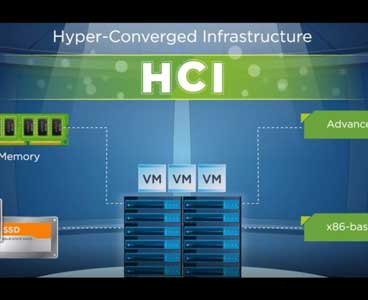Email us at info@ocgl.net
Email us at info@ocgl.net
Blog
Hyper-Converged Computing Infrastructure (HCI) simplifies computing deployment.
07Jun 2024

Hyper-Converged Computing Infrastructure (HCI) simplifies computing deployment and management, providing a flexible and scalable environment that can lead to a lower total cost of ownership (TCO) than traditional data center technologies. The benefits to businesses of all sizes and within all industries are immense, but – as a Business head – what does it mean for you?
In ‘layman’s terms’, an HCI working environment gives a company:
Simplified IT
HCI is made up of tightly integrated components that make hardware and software work as a cohesive unit. Deployments are quick and easy, and certainly less painful than putting the system together yourself. With hyper-converged computing, you spend less time configuring and optimizing components than you would with a traditional piecemeal system. HCI uses a hypervisor to combine all the components into a shared resource pool, which lets you manage the pieces as a single unit.
Agility
Much of the flexibility you gain with hyper-converged computing is a result of HCI’s cloud-like architecture, which provides a single shared resource pool, eliminating the need for isolated infrastructures to meet specific workloads. Within HCI, you can implement centralized workloads of various types and sizes, then deliver them through a software-managed infrastructure. This lets you easily deploy and maintain a wide range of applications and services.
Hyper-converged computing can be especially beneficial to organizations with remote locations or branch offices where space and IT resources are limited, and testing using HCI products can be achieved without special environments. HCI scales out to meet the needs of changing workloads. Start with only the capacity you require and then add to it as your needs change, meaning predictable performance and costs as you project future requirements.
Lower TCO
Here are a few examples of the ways hyper-converged infrastructure can help you achieve a lower Total Cost of Ownership (TCO):
Hyperconvergence incorporates compute, storage and networking, integrating them all into a single solution, and is designed to be easy to buy, deploy and operate, offering streamlined deployment, management and support, so businesses use it to think less about their data centers.
A key characteristic of HCI systems differentiating them from traditional infrastructure is their ability to provide all compute, storage, and networking functionalities through the same server base or ‘node’. These nodes are usually deployed as clusters with three or more nodes per cluster, and each node contributes all its resources to an abstracted pool of capacity, memory, and compute resources, providing the foundation for all server-and storage-centric workloads. These integrated technologies, managed as a single system through a common tool set, can be expanded through the addition of nodes to the base unit. However, with less backup data stored on the HCI itself, there is less pressure to buy more on-premise nodes for capacity.
Businesses invest in a Pre-configured bundle of storage, server and networking hardware and software in a single chassis with the goal of minimizing compatibility issues and simplifying management providing its primary benefits: Ease of management and scaling. Because these components have been designed from the ground up or modified to work tightly together, it is possible to manage all resources from one management tool or console, including compute, storage, networking and virtualization.
For SMB and Enterprise businesses, HCI provides a lower cost computing platform that immediately offers more capability and power than their competitors still using a patchwork of ill-matched, legacy systems. The smaller business owner with vision and a desire to quickly expand now has access to a technical working environment that does everything they want and is scalable – ready for sudden growth spurts, all with cost certainty in both Capital and Operating expenses.
For larger organizations, HCI is the only way to scale to hundreds — or even thousands — of hypervisor hosts. It reduces the capital expenses of the company’s storage infrastructure, datacenter infrastructure complexity, while helping the infrastructure team become more agile, ensuring the correct support, while a rapidly expanding business while remaining “lean”.
So, the Hyper-Converged Business is leaner, faster, more efficient, ready to grow easily without having to spend more on entirely new computing architectures and has more cost certainty in both everyday expenses and long-term capital spend. As Information technology becomes all-encompassing Business technology, this tool kit is a fit for all businesses.